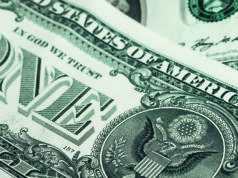
My household had a longstanding Christmas tradition. In the months leading up to the big day, my wife would craft a gift budget for our three sons. She would then blow said budget on mirth-busters like socks, books and, heaven forbid, educational toys.
Around Dec. 20, I’d look through this impending wreckage of our children’s hopes and dreams and offer up a passive-aggressive comment like, “I never would have thought to buy the New York Times crossword puzzle desk calendar for a four-year- old.” Her standard reply isn’t really printable here, but let’s just say I knew what to do. I understood the secret about boys that eluded my wife. They don’t really want specific things. They just want things. So every year I take what’s left of the budget and it’s go time. Shock and awe.
Pulling up to the Toys R Us on Christmas Eve, I looked much like the other deadbeat dads. But I was different. I had a PLAN. Grabbing two shopping carts, as I strolled down the center aisle my demeanor announced: “Make way fools, amateur hour is OVER. We may all be slackers and procrastinators here, but I am your king.”
There are three general categories of toys that my sons love. Things with teeth, things with wheels, and things that can be used to (hopefully just) simulate maiming your brothers. With Terminator-like efficiency, I quickly process the aisle labels. Jurassic Park Playsets (things with teeth), Matchbox/Monster Trucks (things with wheels), Nerf Missile Launchers (things that maim), Barbie/Disney Princesses (abandon all hope ye who enter here).
Passing this last aisle, I avoid eye contact with all of its desperate residents. Dads (it’s always dads) who clearly have not spent enough time with their daughters and are now trying to make up for it with a grand gesture. They are the Last and the Furious. It’s almost midnight Chad. Which My Little Pony does Sophie have her heart set on? Rainbow Sparkle or Pinkie Pie? Tick tock.
My secret power was that I actually knew my kids. This may not seem like much but compared to my fellow consumers in this rural Louisiana Toys R Us at 10:33 p.m. on Christmas Eve, I was Father of the Frickin’ Year.
Our time-honored tradition ended in 2017 with the bankruptcy of Toys R Us. What killed this profitable national chain? Private equity.
And now, as they say, the barbarians are at our gates. Are we ready? First, let’s review private equity FAQ style. Don’t worry, my financial education capped at ECON 101. There will be no mention of Adam Smith or The Wealth of Nations.
What is private equity?
Private equity (PE) is best thought of as a financial strategy. The basic goal is to achieve higher returns than are generally possible in the public market. Therefore, PE investments are made in companies or entities that are not publicly traded. If the company is public, the PE firm takes it private after the acquisition.
Why does PE take their companies private?
In response to the rampant corporate fraud that led to the stock market collapse of 1929, Congress passed the Securities Act of 1933 and the Securities Exchange Act of 1934. These laws forced corporations seeking money from the public to disclose a wide array of financial and legal information. All of this information would be regularly reviewed by the Securities and Exchange Commission (SEC). Private companies were limited to only 100 investors. However, following a wave of deregulation in the 1980s, the National Securities Markets Improvement Act of 1996 allowed private funds to raise unlimited money from an unlimited number of investors. Following this Act, the number of private companies skyrocketed as they faced significantly less regulation than public firms.
Why is the strategy so successful?
PE investments usually have a time horizon of four to seven years to yield favorable returns. General strategies revolve around cost-cutting: pay cuts, store closings and layoffs. In addition to Toys R Us, Sports Illustrated, Nabisco, Twitter and even Taylor Swift were all significantly affected by PE investments. However, not all PE interactions have negative outcomes. Dollar General and Michaels survived their buyouts as healthy companies. Under ideal circumstances, PE firms can offer the expertise to turn around poorly performing businesses by eliminating operational inefficiencies and increasing profits.
How does a PE firm finance its acquisitions?
Most of the money is borrowed, and this debt is immediately transferred to the acquired company. In the case of Toys R Us, the PE firm transferred billions of debt to the corporation. This is referred to as a leveraged buyout. So, at a time when Toys R Us should have been overhauling its infrastructure and strategies to compete with the growing online market, it had to use its revenue to pay off this massive debt. Despite remaining profitable, Toys R Us ultimately had to declare bankruptcy.
What else can PE firms do to ensure profit even if the acquired business eventually fails?
Since the PE firm now owns the acquired business, it can do a lot to harvest cash. A common tactic is the sale- leaseback. In this case, the PE firm will instruct the company to sell assets to pay off the debt it has now incurred from the leveraged buyout. Often, a company’s most valuable asset is its real estate. In a sale-leaseback, the PE firm directs the company to sell its land to the firm, and then the firm will lease it back to the company. PE firms can also charge the acquired corporation exorbitant “management” fees. Since the firm owns the business, it doesn’t need to do anything to earn these fees.
One instructive example is the purchase of the nursing home chain HCR ManorCare by a PE firm, the Carlyle Group, in 2007. As detailed in the New York Times, Carlyle paid just over $6 billion, most of which was borrowed. It then saddled ManorCare with the debt and recovered its investment by selling ManorCare’s real estate. ManorCare then had to pay rent for the buildings it once owned. Carlyle also charged ManorCare $80 million in transaction and advisory fees. ManorCare began cost-cutting programs and layoffs, resulting in health code violations. Eleven years after the purchase, ManorCare filed for bankruptcy with over $7 billion in debt. Carlyle, however, made millions over its initial investment. Carlyle executives even give talks at industry conferences about structuring investment portfolios to include nursing homes.
What would it look like if you planned a PE takeover of your household?
I’m glad you asked this oddly specific and leading question. I imagine the conversation with my wife would go as follows, “Look, you’re a good earner, but under investments and assets you wrote one word, ‘shoes.’ The nanny seems pretty frugal. I’m making Luisa the CFO. The two older kids are sunk costs at this point. But the youngest’s grammar school is crazy expensive. Also, he says he wants to be an artist. That’s a long road to a return on our investment. We are going to have to lay off Luke. And the dog.”
What makes healthcare attractive to PE firms?
The healthcare industry is often seen as recession proof. The U.S. spends about $4.5 trillion on healthcare, almost 20% of its gross domestic product, the highest among developed countries. PE firms see this spending as a spigot, unlikely to be turned down.
Over the past decade, almost $1 trillion has been spent by PE in acquiring medical practices. And now that we know the PE playbook, the results are predictable. The goal of purchasing physician practices is the same as for buying companies. Turn a 20–30% profit on investment in four to seven years.
PE acquisitions of physician practices rose from 75 in 2012 to 484 in 2021. In more than one fourth of metropolitan areas, a PE firm has at least a 30% market share in a medical specialty. Studies have shown that prices rise when PE firms achieve this 30% threshold. Nationally, 25–40% of emergency rooms are staffed by PE firms.
A JAMA Internal Medicine study by La Forgia and colleagues showed that prices charged by PE-backed anesthesia groups rose 26% from 2012–2017. The financial burden is passed on to patients through higher out- of-pocket fees and rising premiums. The No Surprises Act was a response to unsavory PE billing policies. It is unlikely that physicians see much of the increased revenue, as PE’s goal is to increase profits for its investors. In fact, many PE-owned anesthesia practices replace physicians with nurse anesthetists to save money.
In dermatology practices, physicians have been told to generate profits by increasing elective procedures, ancillary services, and charges. This profit-driven model also threatens health equity. Reimbursements can be maximized by prioritizing commercially insured patients in higher-income communities. Quicker, lower-complexity procedures are also emphasized over delivering complex care.
Scale of PE role in medicine
The true influence of PE in medicine is difficult to measure as their firms have few ownership disclosure requirements. Also, the physicians are routinely required to sign non-disclosure agreements. Even for doctors getting acquired, it can be impossible to tell who is truly buying their practice. This lack of transparency makes monitoring the actual effects of PE on healthcare nearly impossible. Still, what we do know is damning. In deference to my poorly enforced word count and readers’ attention span, I will not detail all of PE’s plundering and blundering exploits in medicine. But for those not convinced, simply search Envision Healthcare, US Anesthesia Partners, Kool Smiles, or Prospect Medical Holdings.
I believe PE acquisitions are just a symptom of healthcare’s overall problems. Physicians are selling their practices because it is too hard to remain financially solvent on their own. Paperwork, legal requirements, electronic health records and insurance practices have all placed incredible strain on private practitioners. The majority of physicians enter practice with extraordinary educational debt. Hospital system consolidations make it difficult for smaller practices to compete. Many physicians reject the notion of hospital employment but have few options. PE employment offers a potentially lucrative alternative.
The specter of non-compete clauses and loopholes
In addition to raising prices, PE firms strive to generate more income from physician practices by purchasing lower-cost supplies, substituting lower-paid staff such as medical assistants for nurses, having physicians see more patients, and seeking a better payor mix. The firms also lock the physicians into the practice through non-compete clauses.
The American Academy of Emergency Physicians notes: “The goal of non-compete clauses is to intimidate the emergency physician into unquestioning servitude to business interests. Given physicians’ ethical obligation to patients, many continue to speak out for patient safety; however, knowing that they can be fired at will and then forced to relocate their family to another city or state can have a chilling effect on physicians’ advocacy for patients.”
The legal ability of PE firms and their medical management companies to control medical decision- making and clinical care is determined at the state level and varies enormously. Nearly 20 states have no rule prohibiting medical management companies from manipulating clinical practice and medical judgment. Even where regulations exist, PE firms can find loopholes, such as naming the physicians as practice owners while having a parent company control the actual finances.
In the world of corporate medicine, these are known as “friendly” or “straw” doctors. Often, they will have their name attached to hundreds of practices. Amazon’s One Medical primary care subsidiary and UnitedHealth-owned Optum Health have been accused of this practice. Oregon is currently debating a bill to outlaw this “corporate practice of medicine.” Both Amazon and UnitedHealth Group have retained lobbyists to oppose it.
PE firms also protect themselves politically. Their employees include former cabinet members, secretaries of state, chairmen of the SEC, chairmen of the Federal Trade Commission. speakers of the House, a CIA director, a vice president, and various senators.
Still, much can be done to combat PE’s influence on medicine. Financial and bureaucratic burdens on practicing physicians must be eased. Indiana, for example, recently passed a tax credit for independent physicians. Other possible financial improvements include Centers for Medicare & Medicaid Services (CMS) payment reforms, reconsidering fee-for-service, and capitated payments for quality care.
Uniting with other specialties to support complete ban
The most direct and achievable method for curbing the undesired aspects of PE influence on physician practices may be to enforce the FTC’s proposed ban on non-compete clauses. If PE firms could not prevent physicians from walking away, it would force them to change their approach to management. Instead of rampant cost-cutting and forcing physicians to do more with less, this could incentivize PE to retain doctors by improving salaries and working conditions.
Even if enacted, the FTC’s proposed non-compete ban will likely face many challenges in court. Most conservative judges, including some on the Supreme Court, have signaled that they don’t favor federal agencies asserting new regulatory authority based on old statutes.
Vascular surgeons should join with other specialties that have already been pillaged by PE to support a complete ban on non-compete clauses for doctors. Only by uniting our physician advocacy efforts do we stand a chance against the private equity-backed lobbyists.
Malachi Sheahan III, MD, is the chief medical editor of Vascular Specialist. His opinions do not reflect SVS policy or positions.












